[Troubleshooting][xDSL] What can I do if my xDSL modem router often gets disconnected?
When your xDSL modem router often has DSL disconnection issue, you may refer to the following steps for trouble shooting.
Before the trouble shooting steps, please confirm with your ISP regarding the xDSL type required for your xDSL service plan and confirm whether the relevant xDSL WAN setting parameters are correct and whether the cable is normal, then please check the xDSL data rate support specifications for ASUS xDSL modem router on ASUS official website
If the xDSL type provided by ISP does not match the xDSL specification of your current xDSL modem router, it means that the model does not support the services provided by the ISP and the connection cannot be successfully established. It is recommended that you purchase a model that conforms to the ISP service plan.
Please refer to the following steps to confirm the specifications of xDSL modem router on ASUS official website.
(1) Please go to ASUS Global site https://www.asus.com/ , click search 
(2) Enter the model name of your ASUS xDSL modem router then press Enter Key to search. Here we take DSL-AC68U as an example.

(3) Click [more] to DSL-AC68U product page.

(4) Go to Tech Specs to see detail specification of DSL-AC68U

(5) The specifications for the supported xDSL type and data rate.
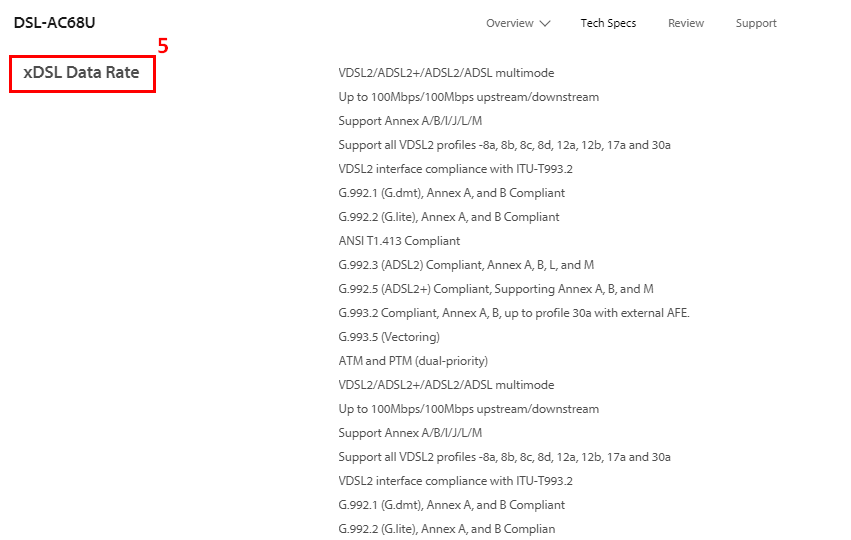
Trouble shooting steps
Step1. Reboot your xDSL modem router
Sometime the unstable issue can be resolved by rebooting, please press the Power button off and on to reboot your DSL modem router.

Make sure the power LED and DSL LED indicator on the front of the router stays on. The WiFi 2.4G/5G LED indicators will start flashing, indicating that the router is turned on.
For details, you may refer to the user manual.
*Below picture for your reference.
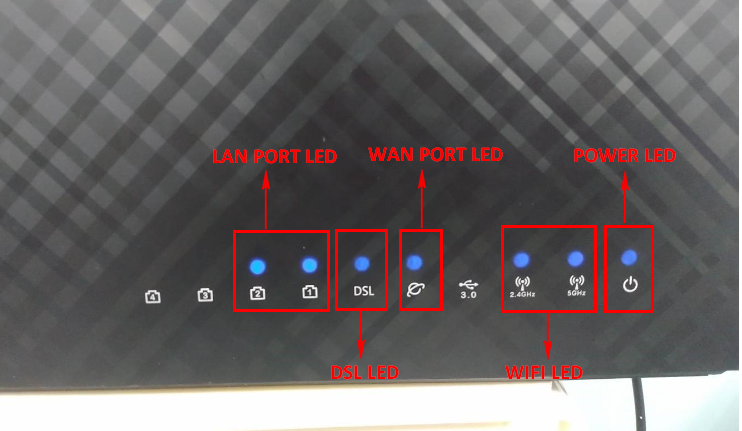
Step2. Please make sure that your DSL modem router is connected correctly.
Kindly refer to the following picture and steps to check if the power and phone cords on the DSL router are correctly plugged into the power outlet, router, phone jack and the computer.
If one of the cables is not connected, please reconnect the cables.

Detail steps about how to connect the cables correctly.
1. Insert DSL modem router’s power adapter to the DC-IN port and plug it to a power outlet.
Note 1: After connecting to power supply, remember to press the Power button to turn on the modem router.
Note 2: After turning on your DSL modem router, wait for about two to three minutes for it to boot up.
2. There are two phone cables involved here: one from the modem to the splitter and one from the splitter to the phone port on the wall. It can be either one of them.
Please take out the splitter and connect the modem to the wall line directly or replace the above two phone cables.
Connect one end of the RJ-11 cable to the DSL port of DSL modem router, and connect the other end to the DSL port of your splitter.
3. Use a network cable (RJ45) to connect your computer to DSL modem router’s LAN port.
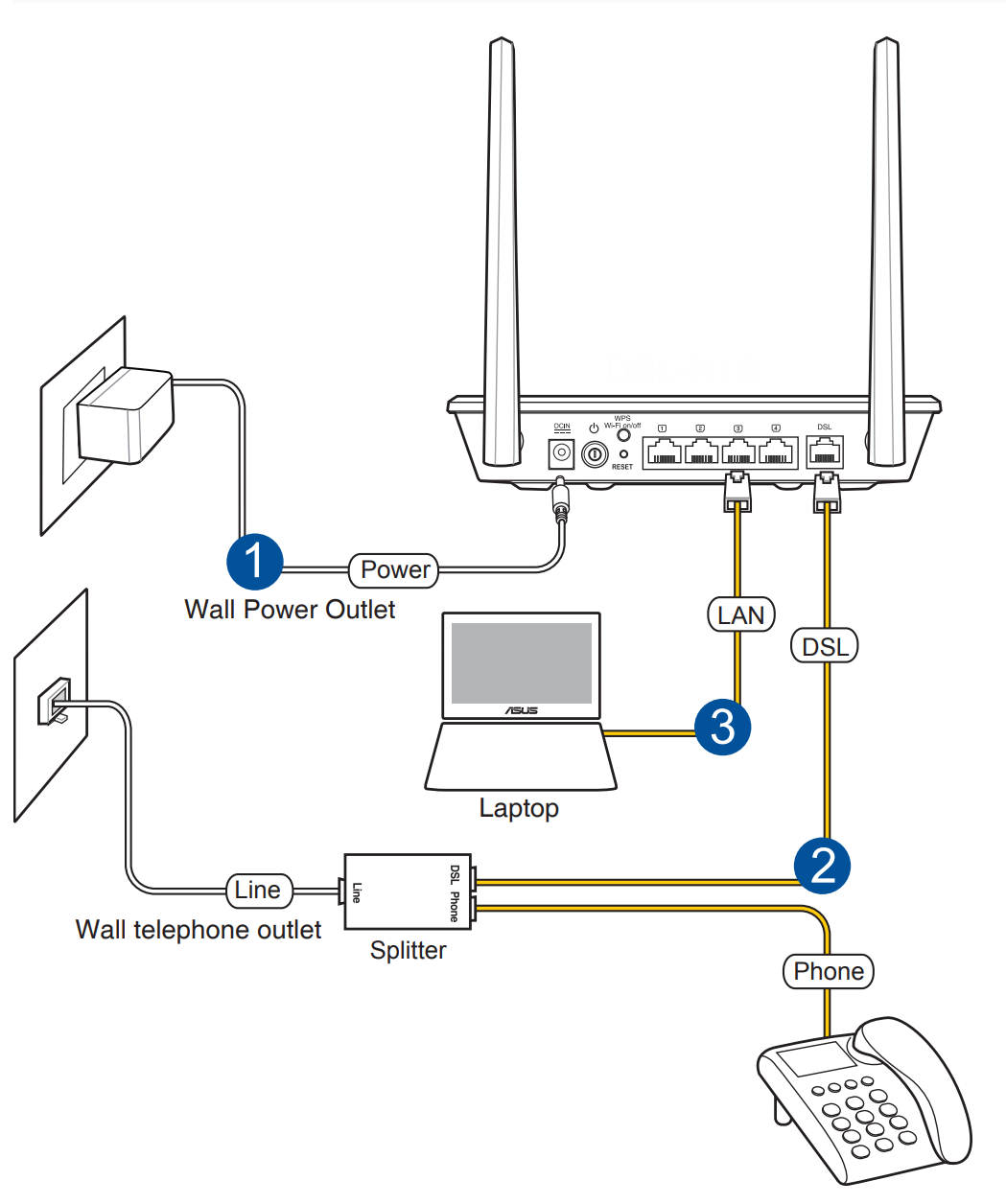
- Note that the specifications of the splitter are not the same. To avoid wrong wiring, please check the port and guidance on the splitter to confirm that the wiring is correct.
- The line may be affected by telephone signals if without the Splitter. If you do not have Splitter at hand, we suggest you check with your ISP if it is available.
(The picture below is an example of Splitter)

Step3. Update the firmware and have a reset for your xDSL modem router.
You can either perform a live update or update manually through ASUSWRT (Web GUI). Before you login to Web GUI, please have your computer cable connected to your xDSL modem router, then launch the web GUI, go to Advanced settings > Administration > Firmware Upgrade tab. Click Check to verify if the latest firmware is available.
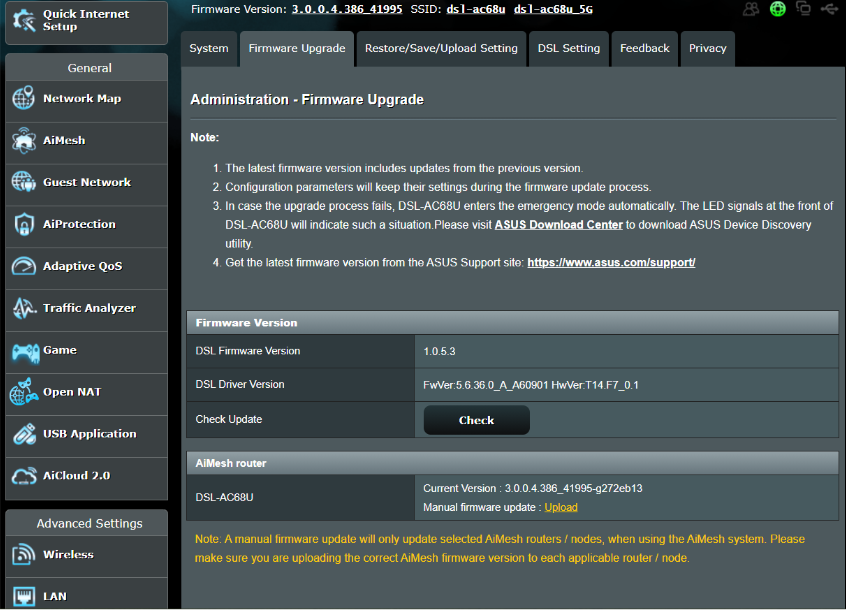
Note: For the detail process of how to upgrade firmware, please refer to How to update the firmware of your router to the latest version ? (WebGUI)
After firmware upgrade, please restore xDSL modem router to default settings
(1) Press the RESET button around 5~10 seconds until the Power LED indicator of router starts flashing, then you could stop pressing.
In the meantime, all the LED indicators of the router should be off. It is a normal phenomenon because the router is rebooting itself.
Wait until the Power LED indicator and Wi-Fi LED indicators are on again, you could try to enter the GUI of the router again.
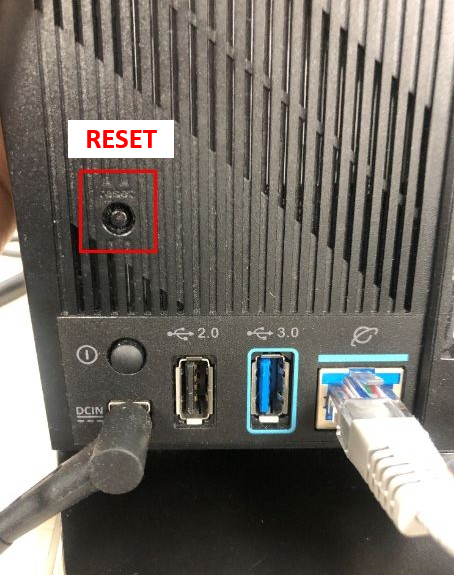
Notice: After resetting the router, all the settings will be cleared and will need to be setup again by the Quick Internet Setup (QIS).
Please make sure that the Power LED, DSL LED, WIFI LED status stays on then start the QIS. If the DSL LED does not light up, please contact ISP to make sure the line is working normally or try to change the RJ11 cable.
When the DSL LED light up, please wire connect your computer to xDSL modem router then proceed the Quick Internet Setup (QIS). If still cannot establish DSL connection, please try to do it manually.
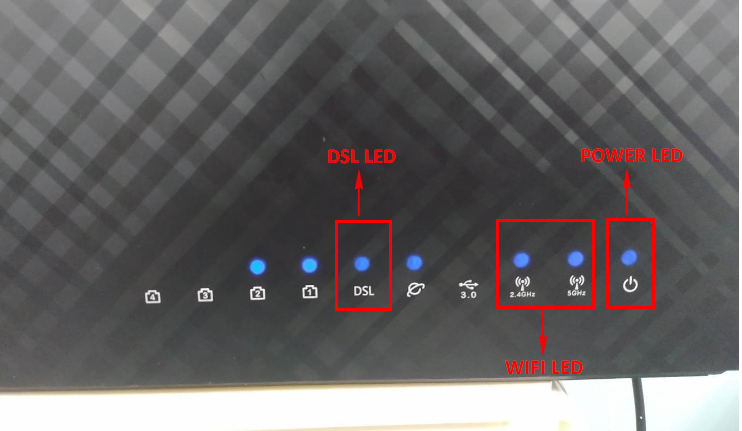
Step4. If still having unstable connection issue, please try below suggestions.
(1). Cross test to confirm that the disconnection is happening between ISP to Asus Modem or client device to Asus modem.
Please test through all your wired devices (laptops or desktops) and wireless devices first to confirm that it is not a single device abnormality.
If only a single device has frequent disconnection problems, it is recommended that you contact the device manufacturer for support.
If you find that the wired device is connected normally, only the wireless device will be disconnected frequently, please refer to this FAQ [Troubleshooting] Wi-Fi signal is often disconnected
If all wired devices have frequent disconnection problems, please make the following adjustments.
(2). DSL Modulation :Base on the ISP provided service plan and modulation mode to manual adjust the DSL modulation; most situation can set to Auto Sync-up.
However, when you check the DSL log and found the detected DSL modulation is different, you may manual adjust the modulation mode base on DSL log information.

(3). Adjust the [Stability adjustment] to get better signals. This item configures SNR Margin offset. If your DSL connection is unstable or is not able to establish a connection, set the value to a negative dB, for example -1dB. If the issue persist, set the value to -2dB ~ -10dB (Max. Stability). For a normal DSL connection values are 1dB ~10dB (Max. performance)
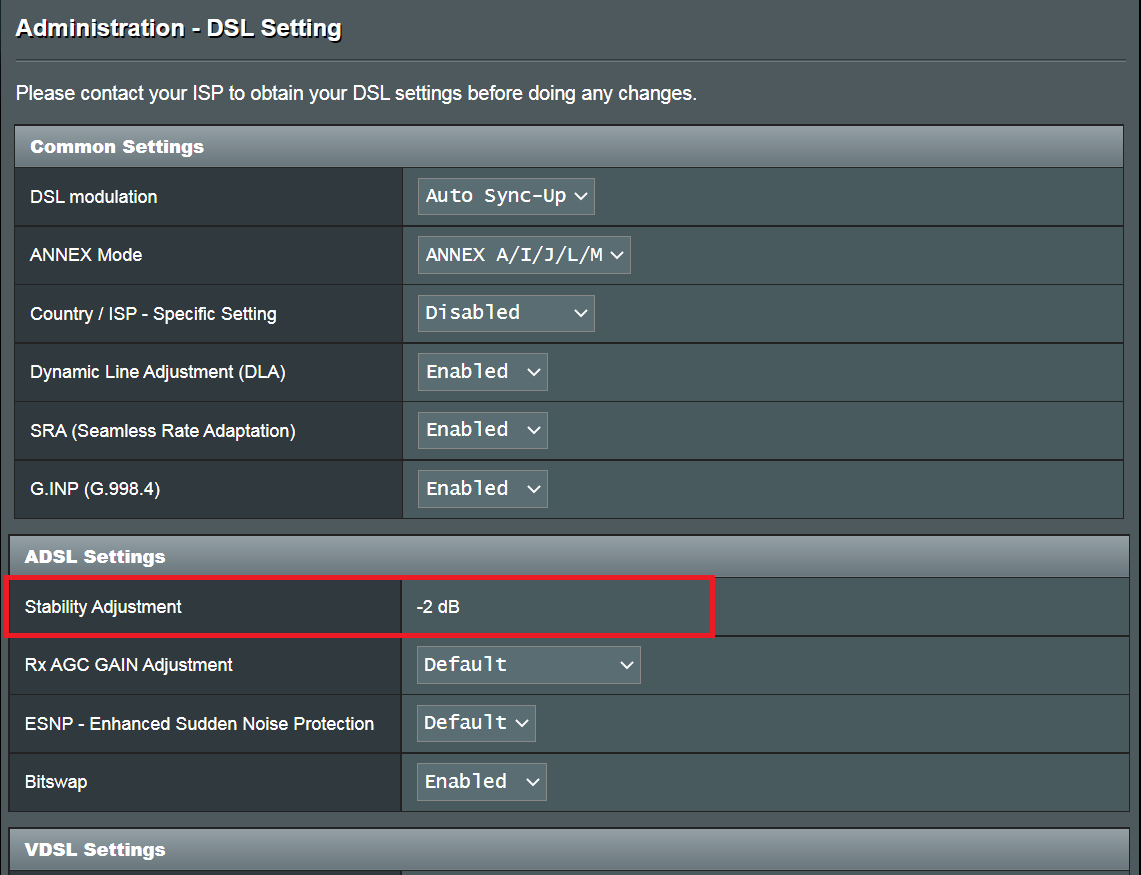

(4) Adjust the [Bitswap] option to get better signal. You may change it to enable or disable to try if DSL connection is getting stable or not.

If all above does not helping and ISP confirmed the line is normal, please submit a feedback from web GUI for further troubleshooting.
Feedback steps
1) Reset to default settings, and complete the QIS.
2) Set the [DSL Modulation] to [Auto sync-up].
3) Set the [Country / ISP - Specific Setting] to [Disabled].
4) Set the [Dynamic Line Adjustment (DLA)] to [Disabled].
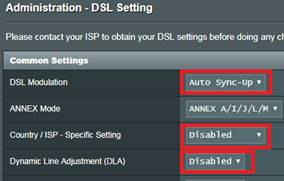
5) Plug in a USB disk to the router.
6) Submit a Feedback form with [DSL Line / Wi-Fi Diagnostic *] option set as [xDSL line] and [Diagnostic debug log capture duration] set as the time you think the problem will occur. (e.g. [24 hours], if there is no problem during this time, you will need to do this test again.)

7) Please notify us after the feedback is sent and provide the email used for sending and the test time you set (the system will automatically send the test log to us, we collect data by email)
8) Provide us the [DSL Log] screenshots when normal and abnormal. (in System Log -> DSL Log page, not [System Log - General Log] page).
E.g.
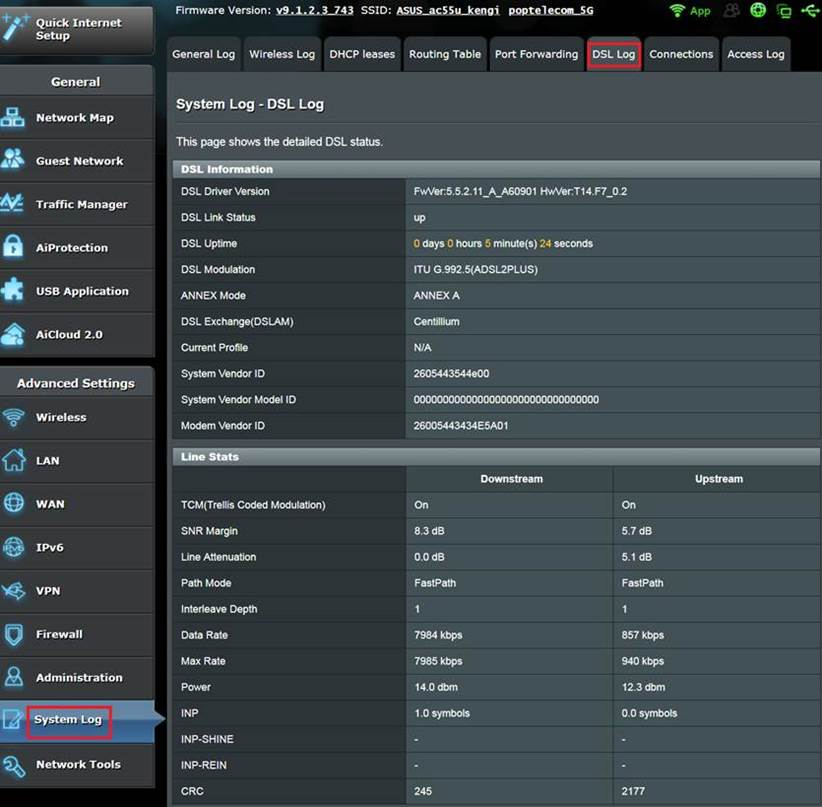
9). When the Diagnostic debug log capture is done (The upper right corner connection icon changes back to green ), refresh the UI page, and click the exclamation mark in the upper right corner. Then click the [Send debug log now]. (Need to insert the original USB disk.)
), refresh the UI page, and click the exclamation mark in the upper right corner. Then click the [Send debug log now]. (Need to insert the original USB disk.)
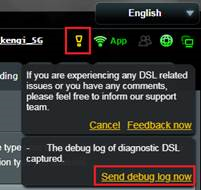
By doing so you will enter a special feedback page. Please click on the link below to save the debug log (WiFi.log.gz). Send it to us for analysis.
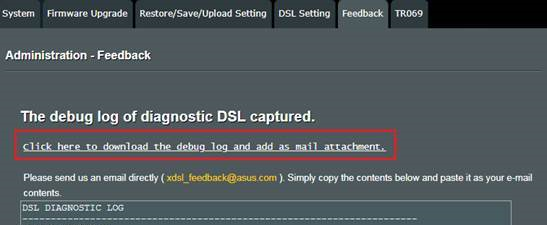
10). If the above steps cannot be performed or feedback fails to send for some reason, you can also send the log located in your USB to us via Support. (Logs will be located In USB:\asus_diagnostic\WiFi.log.gz)
11). After you send out the log and email, please contact ASUS service center to provide related information for tracking. https://www.asus.com/support/





